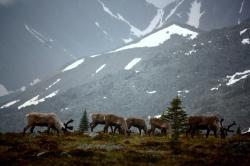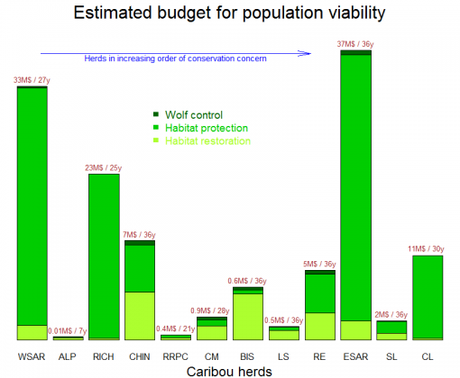Here’s another great post from Salvador Herrando-Pérez. It is interesting that he’s chosen an example species that was once (a long, long time ago in a galaxy far, far away) of great interest to me (caribou). But that is another story. Take it away, Salva.
–

–Figure 1. Caribou (reindeer) are ungulates weighing up to ~ 100 kg. They live in tundra and taiga in Finland, Greenland, Finland, Norway, Mongolia, Russia, Canada and USA (extinct in Sweden). The species is globally stable (‘Least Concern’, IUCN Red List), but the subspecies of woodland caribou (Rangifer tarandus caribou) is threatened in North America. Schneider and colleagues’ 7 study encompasses ~ 3,000 individuals in 12 herds (75 to 450 individuals per herd), occupying ~ 100.000 km2 of conifer forest and peatland (3,000 to 19,000 km2 per herd). Two ecotypes are recognized regionally22, namely migratory mountain herds (mostly from mountains and foothills in west-central Alberta), and non-migratory boreal herds (mostly from peatlands in central and northern Alberta). The photo shows a group of caribous grazing on subalpine vegetation from Tonquin Valley, Jasper National Park(Alberta, Canada). Photo courtesy of Saakje Hazenberg.–
As conservation biology keeps incorporating management and economical principles from other disciplines, it stumbles with paradoxes such that investing on the most threatened components of biodiversity might in turn jeopardize the entire assets of biodiversity.
At the end of 2011, newspapers and TVs echoed an IUCN report cataloguing as ‘extinct’ or ‘near extinct’ several subspecies of rhinos in Asia and Africa. To many, such news might have invoked the topic: “how badly governments do to protect the environment”. However if, to avoid those extinctions, politicians had to deviate funds from other activities, what thoughts would come to the mind of workers whose salaries had to be frozen, school directors whose classroom-roof leakages could not be repaired (e.g., last winter at my niece’s school in Spain), colonels whose last acquisition of ultramodern tanks had to be delayed, or our city council’s department who had to cancel Sting’s next performance.
Thus, there are three unquestionable facts regarding species conservation:
- the protection of species costs money;
- governments and environmental organisations have limited budgets for a range of activities they deem necessary; and
- our way of conserving nature is failing because, despite increasing public/private support and awareness, the rate of destruction of biodiversity is not decelerating1,2.
One of the modern debates among conservationists pivots around how to use resources efficiently3-6. Schneider and colleagues7 have dealt with this question for woodland caribou (Rangifer tarandus) in Canada. A total of 18 populations of this ungulate persist in the Canadian province of Alberta, all undergoing demographic declines due to mining extractions (oil, gas and bitumen), logging and wolf predation. The species is listed as ‘threatened’ regionally and nationally. The Alberta Caribou Recovery Plan (2004-2014) is attempting to protect all herds. Under such a framework, Schneider et al.7 predicted that woodland caribou would be regionally extirpated in less than a century.
Furthermore, they estimated the costs of making each herd viable (Fig. 1), with a triple revelation. To save all herds from extinction would need ~ CA$150,000 million (beyond the available budget). The most threatened herds are among the most expensive to protect (within present management approach). Some herds would be secured through modest investment for two decades. Overall, their study suggests that Alberta’s woodland caribou would be eligible for triage, i.e., at the subpopulation level8.

–Figure 1. Estimated budgets to protect 12 of the 18 woodland caribou herds in Alberta (Canada)7. In the graph, herds are ordered (left to right) from (current) increasing threat (estimated as time until herd size is < 10 individuals given current population size and decline rates). Bar height is proportional to the magnitude of investment needed to avoid population extirpation (bar tops show investment amounts in millions of Canadians dollars [M$], and investment periods in years). Conservation measures include forest restoration (bar subsection = M$), habitat protection with zero exploitation of natural resources (100xM$), and wolf control (M$). For instance, Cold Lake (CL) and Athabasca River East (ESAR) herds are among the most threatened populations and require considerable costs for 36 years; Richardson (RICH) and Athabasca River West (WSAR) herds could be recovered in 25-27 years at a relatively high price; and A la Peche (ALP) and Redrock-Prairie Creek (RRPC) herds would be viable in 7-21 years with minimal cost. The observed differences reflect contrasting fertility/survival rates, spatial distributions, and industrial developments across herds and habitat ranges. By applying principles of triage, managers would establish a sequence of herd-by-herd investment to maximize the total number of viable herds in the future. This is not to say that triage is infallibly objective, because it relies on heavy computation, numerous assumptions, and multiple predictors. Thus, Wasser et al.19 have used resource-selection models to show that wolves might target mainly deer to the east of Athabasca River where Schneider et al.7 considered wolf culling to alleviate predation on caribou; further caveats address assumptions and methods to calculate population growth rates20-22.–
‘Triage’ means to classify cases by order of treatment given finite resources9. This French concept originated in emergency medicine (e.g., during wars, environmental catastrophes, etc.), in situations where shortage of resources prevents everybody’s treatment, each wounded individual requires immediate care, and the probability of survival (according to lesion severity and therapy complexity) varies among individuals.
Let’s imagine that the war-wounded soldiers and civilians are caribou populations, or species sharing forests and savannas with rhinos, or habitats and countries for which WWF scrutinises its funding. Triage in medicine and conservation biology are similar in that both aim to maximise the number of survivors. Nevertheless, in a situation of emergency, medical triage would mean not treating a moribund individual in the first place if the resources at hand could compromise the survival of other individuals, whereas in conservation biology moribund populations/species/habitats often attract the majority of funding10,11.
Those who defend the application of triage schemes in conservation biology argue that to protect all biodiversity is impossible, that prediction of management costs and protection success rates should determine what to conserve (e.g., 12,13), and that relative evidence for different extinction/viability scenarios could motivate further funding from governments and sponsors14. Those who object to triage qualify it as defeatist and immoral because the sacrifice of some components of biodiversity is proposed as a conservation strategy, which could arm unscrupulous politicians and business people against investment to prevent extinctions (e.g., allowing eradication of large predators blamed for cattle kills), and because it ignores the science underlying conservation efforts that make the most progress (arguably) when confronted with imminent extinctions15,16.
The ongoing controversy juggles ethical and financial matters. An alien visiting the Earth (and equipped with more common sense [“sound and prudent judgment based on a simple perception of the situation or facts”] than the human race) would find it astonishing that the countries which rule the world’s economy invest less on protecting the planet than on destroying it (armament), or searching for new planets (astronautics). Let alone the surmounting evidence that biodiversity and habitat losses ruin ecosystem services (pollination, fisheries, carbon sequestration, etc.) that are vital for human survival, and that well-planned conservation programs can yield nothing but outstanding revenues17
So the protection of (perhaps most of) all biodiversity is technically possible at a reasonable price (e.g., 18), but certainly sounds chimerical given the dominating political status quo of indefinite economic growth which, in practice, still externalizes the monetary value of biodiversity. In the short-term, environmental managers faced with limited resources already do practice triage routinely, even if implicitly and intuitively (like protecting what is most threatened). Therefore, the explicit incorporation of triage strategies in environmental policy and management has the valuable virtue of converting conservation planning to a quantifiable (and potentially more objective) process.
–
References
- Butchart, S. H. M. et al. Global biodiversity: indicators of recent declines. Science 328, 1164-1168, doi:10.1126/science.1187512 (2010)
- Stokstad, E. Despite progress, biodiversity declines. Science 329, 1272-1273, doi:10.1126/science.329.5997.1272 (2010)
- Parr, M. J. et al. Why we should aim for zero extinction. Trends Ecol Evol 24, 181-181, doi:10.1016/j.tree.2009.01.001 (2009)
- Marris, E. What to let go. Nature 450, 152-155, doi:10.1038/450152a (2007)
- Jachowski, D. S. & Kesler, D. C. Allowing extinction: should we let species go? Trends Ecol Evol 24, 180-180, doi:10.1016/j.tree.2008.11.006 (2009)
- Bottrill, M. C. et al. Finite conservation funds mean triage is unavoidable. Trends Ecol Evol 24, 183-184, doi:10.1016/j.tree.2008.11.007 (2009)
- Schneider, R. R., Hauer, G., Adarnowicz, W. L. & Boutin, S. Triage for conserving populations of threatened species: The case of woodland caribou in Alberta. Biol Conserv 143, 1603-1611, doi:10.1016/j.biocon.2010.04.002 (2010)
- McDonald-Madden, E. V. E., Baxter, P. W. J. & Possingham, H. P. Subpopulation triage: how to allocate conservation effort among Populations. Conserv Biol 22, 656-665, doi:10.1111/j.1523-1739.2008.00918.x (2008)
- Kennedy, K., Aghababian, R. V., Gans, L. & Lewis, C. P. Triage: Techniques and applications in decisionmaking. Ann Emerg Med 28, 136-144, doi:10.1016/s0196-0644(96)70053-7 (1996)
- McIntyre, S., Barrett, G. W., Kitching, R. L. & Recher, H. F. Species triage – seeing beyond wounded rhinos. Conserv Biol 6, 604-606, doi:10.1046/j.1523-1739.1992.06040604.x (1992)
- Wilson, H. B., Joseph, L. N., Moore, A. L. & Possingham, H. P. When should we save the most endangered species? Ecol Lett 14, 886-890, doi:10.1111/j.1461-0248.2011.01652.x (2011)
- Ferraro, P. J. & Pattanayak, S. K. Money for nothing? A call for empirical evaluation of biodiversity conservation investments. PLoS Biol 4, 482-488, dpi:E105, doi:10.1371/journal.pbio.0040105 (2006)
- Wilson, K. A. et al. Conserving biodiversity efficiently: What to do, where, and when. PLoS Biol 5, 1850-1861, dpi:e223, doi:10.1371/journal.pbio.0050223 (2007)
- Bottrill, M. C. et al. Is conservation triage just smart decision making? Trends Ecol Evol 23, 649-654, doi:10.1016/j.tree.2008.07.007 (2008)
- Noss, R. F. Conservation or convenience? Conserv Biol 10, 921-922, doi:10.1046/j.1523-1739.1996.10040921.x (1996)
- Pimm, S. L. Against triage. Science 289, 2289, doi:10.1126/science.289.5488.2289 (2000)
- Balmford, A. et al. Economic reasons for conserving wild nature. Science 297, 950-953, doi:10.1126/science.1073947 (2002)
- James, A., Gaston, K. J. & Balmford, A. Can we afford to conserve biodiversity? BioScience 51, 43-52, doi:10.1641/0006-3568(2001)051[0043:cwatcb]2.0.co;2 (2001)
- Wasser, S. K., Keim, J. L., Taper, M. L. & Lele, S. R. The influences of wolf predation, habitat loss, and human activity on caribou and moose in the Alberta oil sands. Front Ecol Environ 9, 546-551, doi:10.1890/100071 (2011)
- Boutin, S. et al. Why are caribou declining in the oil sands? Front Ecol Environ 10, 65-67, doi:10.1890/12.wb.005 (2012)
- Wasser, S. K., Keim, J. L., Taper, M. L. & Lele, S. R. To kill or not to kill – that is the question. Front Ecol Environ 10, 67-68, doi:10.1890/12.wb.006 (2012)
- Sorensen, T. et al. Determining sustainable levels of cumulative effects for boreal caribou. J Wildl Manage 72, 900-905, doi:10.2193/2007-079 (2008)

